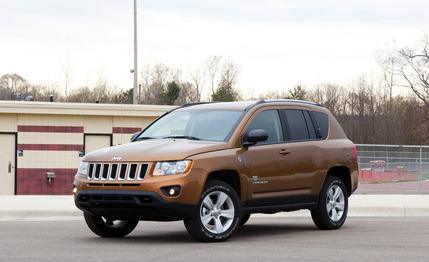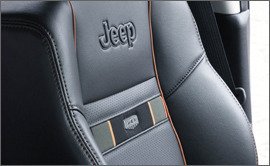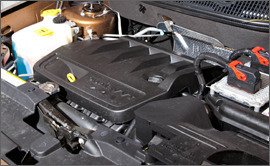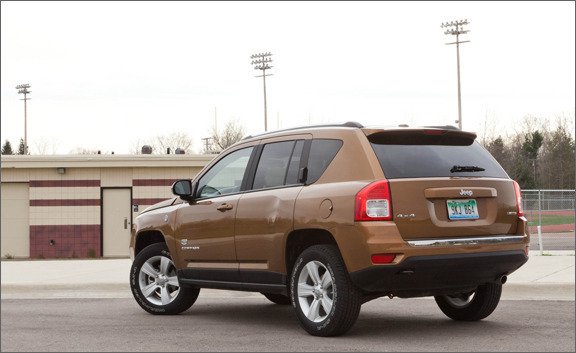
 Short Take Road Test
Short Take Road Test
What Is It?
A platformmate to the Jeep Patriot and Dodge Caliber, and an affront to the ruggedness cultivated by Jeep’s iconic and more capable models, namely, the Wrangler. A more cohesive nose (hood, fascia, grille, fenders, and headlights) inspired by the Grand Cherokee makes the Compass a bit more attractive for 2011, and a much-needed interior refresh adds a new multifunction steering wheel, a redesigned center stack, and a few soft-touch trim pieces. The 70th Anniversary Edition—this example—adds commemorative badging inside and out, 18-inch wheels with all-season Goodyears, leather-trimmed front seats, Chestnut interior accents, and special floor mats.


Powertrains carry over from 2010 and are a base 158-hp, 2.0-liter four and the optional 172-hp 2.4-liter found in our test vehicle. A five-speed manual gearbox is available on base models with or without the lockable all-wheel-drive system, but a dreary continuously variable transmission is the default for all other trims. Mechanical changes for 2011 include a revised and stiffened suspension, and a new-for-2011 Freedom-Drive II Off-Road Group (CVT only) with low-range gearing, skid plates, tow hooks, and a one-inch suspension lift—among other bits—earns the Compass Jeep’s Trail Rated badge. We see this less as a compliment to the Compass and more as a slight to Jeep’s Trail Rated claim.
How Does It Drive?
Slow and unrefined best describe the Compass from behind the wheel. Our test car’s 2.4-liter burbled and thrummed like a diesel at startup, with the CVT turning the exhaust note into a coarse, unrelenting racket under acceleration. Our all-wheel-drive example dawdled to 60 mph in 9.2 seconds and covered the quarter-mile in 17.3 at 82 mph. A lengthy 5-to-60-mph street start and a 50-to-70-mph acceleration time (9.8 and 7.3 seconds, respectively) further illustrate the CVT’s need to gather itself before any increase in forward momentum occurs. As a result of the heavy footwork required to keep the Compass moving, we managed only 19 mpg overall, undercutting the 20 mpg city/23 highway ratings.


The experience is similarly disappointing if you try to turn. The updated suspension struggles to keep body motions in check, and the steering is vague and sloppy, with considerable play in the rack making small corrections a guessing game. We didn’t get a chance to rate the Compass on any trails, but the new off-road gear will allow suburban adventurers to dispatch unpaved roads and gravel driveways with ease. At 3511 pounds, the Compass is on the lighter end of its segment, yet it took a considerable 195 feet to stop from 70 mph. A meager 98-mph top speed and an overzealous stability-control system that limited the skidpad figure to 0.73 g underscore the Compass’s complete unwillingness to play.
How Does It Stack Up?
With a base price of about $20,000, the Compass has myriad competitors in what is one of the fastest-growing segments in the market. The updated all-wheel-drive system and low-range gearing make it arguably more two-track ready than many small utes, with the truckier Jeep Liberty being the primary alternative with some competence in the rough stuff. (There’s also the mechanically similar Jeep Patriot, which is basically a less-funny-looking Compass.) But if added to the eight-vehicle roster of our last $30K small-SUV comparison test, our particular Limited would have placed at or near the bottom in every category, including overall performance, cargo capacity, observed fuel economy, and value. Interestingly, cargo room in the Compass with and without the rear seats folded—23 and 54 cubic feet—is comparable to the tiny Honda Fit’s.
What’s the Cost?
The midrange Latitude trim is required to get many of the Compass’s nicer interior features, and certain options such as in-dash navigation are only offered on Limited trims. A standard front-wheel-drive model with the 2.0-liter four and a five-speed manual starts at $19,995; a Limited with all-wheel drive (a $1700 upgrade) like the vehicle tested here starts at $26,695. The $575 70th Anniversary Edition, a $685 6.5-inch touchscreen navigation system, the $750 Security and Cargo Convenience Group (front side airbags, a security alarm, USB and Bluetooth connectivity, and an auto-dimming interior mirror), the aforementioned $550 Freedom-Drive II package, and the required $1050 low-range CVT jacked the as-tested price to $30,305.
That’s a lot of money for an underwhelming package that couldn’t even fare well in our rental-car comparo. With the updated Jeep Wrangler Unlimited finally sporting an accommodating cabin and starting at about $26,000, we’ll side with the purists here and recommend one of those for Jeep fans’ muddy adventures with the family—and anything else for adventures away from the muck.

